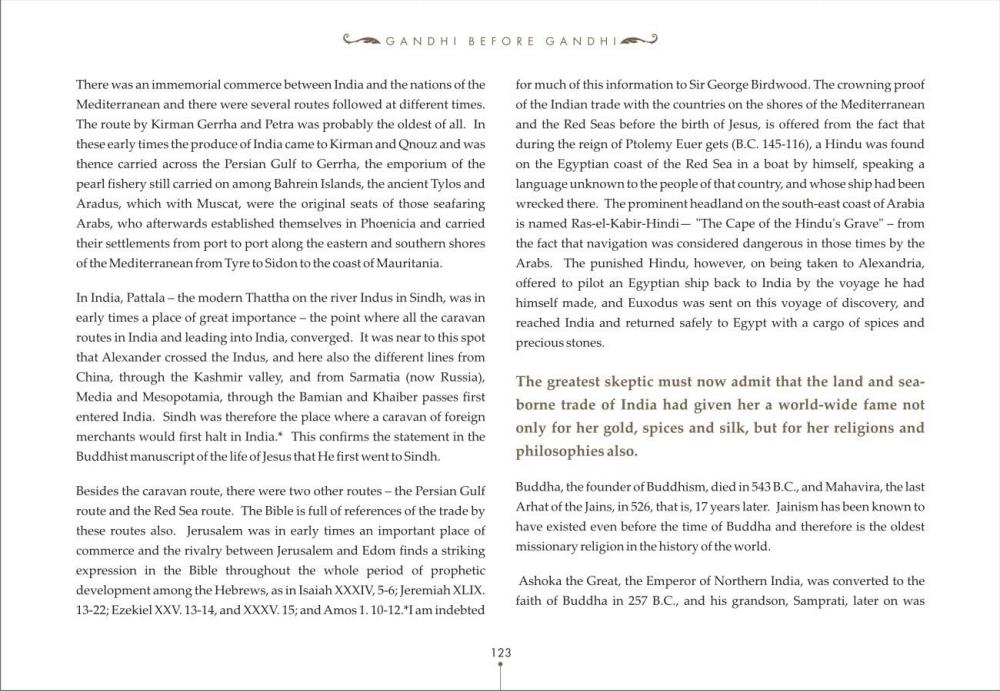________________
GANDHI BEFORE GANDHI
There was an immemorial commerce between India and the nations of the Mediterranean and there were several routes followed at different times. The route by Kirman Gerrha and Petra was probably the oldest of all. In these early times the produce of India came to Kirman and Qnouz and was thence carried across the Persian Gulf to Gerrha, the emporium of the pearl fishery still carried on among Bahrein Islands, the ancient Tylos and Aradus, which with Muscat, were the original seats of those seafaring Arabs, who afterwards established themselves in Phoenicia and carried their settlements from port to Port along the eastern and southern shores of the Mediterranean from Tyre to Sidon to the coast of Mauritania
for much of this information to Sir George Birdwood. The crowning proof of the Indian trade with the countries on the shores of the Mediterranean and the Red Seas before the birth of Jesus, is offered from the fact that during the reign of Ptolemy Euer gets (B.C. 145-116), a Hindu was found on the Egyptian coast of the Red Sea in a boat by himself, speaking a language unknown to the people of that country, and whose ship had been wrecked there. The prominent headland on the south-east coast of Arabia is named Ras-el-Kabir-Hindi - "The Cape of the Hindu's Grave" - from the fact that navigation was considered dangerous in those times by the Arabs. The punished Hindu, however, on being taken to Alexandria, offered to pilot an Egyptian ship back to India by the voyage he had himself made, and Euxodus was sent on this voyage of discovery, and reached India and returned safely to Egypt with a cargo of spices and precious stones.
In India, Pattala - the modern Thattha on the river Indus in Sindh, was in early times a place of great importance - the point where all the caravan routes in India and leading into India, converged. It was near to this spot that Alexander crossed the Indus, and here also the different lines from China, through the Kashmir valley, and from Sarmatia (now Russia), Media and Mesopotamia, through the Bamian and Khaiber passes first entered India. Sindh was therefore the place where a caravan of foreign merchants would first halt in India. This confirms the statement in the Buddhist manuscript of the life of Jesus that He first went to Sindh
The greatest skeptic must now admit that the land and seaborne trade of India had given her a world-wide fame not only for her gold, spices and silk, but for her religions and philosophies also.
Besides the caravan route, there were two other routes-the Persian Gulf route and the Red Sea route. The Bible is full of references of the trade by these routes also. Jerusalem was in early times an important place of commerce and the rivalry between Jerusalem and Edom finds a striking expression in the Bible throughout the whole period of prophetic development among the Hebrews, as in Isaiah XXXIV, 5-6; Jeremiah XLIX. 13-22; Ezekiel XXV. 13-14, and XXXV. 15; and Amos 1.10-12. "I am indebted
Buddha, the founder of Buddhism, died in 543 B.C., and Mahavira, the last Arhat of the Jains, in 526, that is, 17 years later. Jainism has been known to have existed even before the time of Buddha and therefore is the oldest missionary religion in the history of the world.
Ashoka the Great, the Emperor of Northern India, was converted to the faith of Buddha in 257 B.C., and his grandson, Samprati, later on was
123




